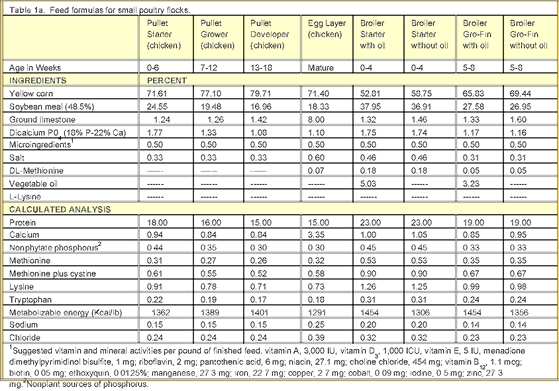



Poultry Diets for Small Flocks
By B.L. Damron and D.R. Sloan, University of Florida - This article looks at the feed formulations for poultry farmers with small flocks and includes tables for calculating the correct ratio of ingredients.
The feed formulations in Tables 1a and 1b are
designed for the flock owner who may wish to
home-mix feeds or have them custom-blended for
their birds. They also allow the incorporation of corn
from sustainable agriculture or organic programs.
These formulations are based on nutrient requirement
recommendations and ingredient nutrient analyses of
the National Research Council. (National Research
Council, 1994. Nutrient Requirements of Poultry 9th
Rev. Ed. National Academy Press, Washington, D.C.,
156 pp.) These diets are designed to be fed in mash
form, and they meet all the nutritional needs of the
various species of birds. It is not necessary to provide
any supplements, such as oyster shell or grit. The feed
should not be diluted with scratch feed or other
grains.
No duck or turkey breeder feeds are shown
because their nutritional requirements are very
similar to those of the laying chicken. Therefore, it is
recommended that the chicken layer formulation be
employed for these birds. A continuous supply of feed
and fresh, clean water should be available to the birds
at all times.
In order to accommodate different mixing
capabilities, formulations with and without vegetable
oil (such as peanut or corn oil) used as an energy
source are included.
The use of the lower energy diets will result in a
somewhat longer growing period and reduced feed
efficiency. We also recommend that a feed additive
to prevent coccidiosis (caused by a protozoan parasite
that invades the walls of the intestine) be added to
feeds for starting and growing chickens and turkeys.
Since quail also have a problem with ulcerative
enteritis, an inflammation of the intestine sometimes
resulting in high mortality, a feed additive to control
this condition is also recommended. A small portion
of the corn can be removed to accommodate
medication addition. As with any medication,
directions concerning approved bird age, dosage
concentration, duration of feeding, and withdrawal
time should be carefully studied and followed.
Supplemental vitamin and trace mineral
activities for the microingredient mix are also
recommended in the footnotes of each table.
For further information on poultry, contact your
local county extension agent.
Source: University of Florida - IFAS Extension - June 2003










